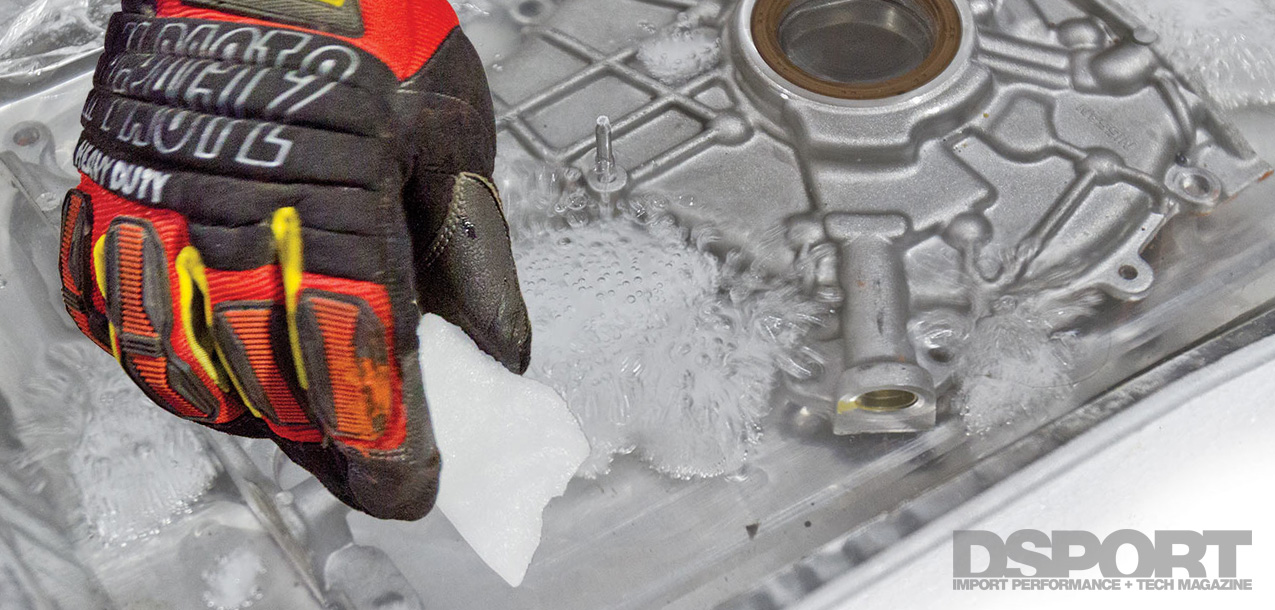Garage Laboratory
[pullquote]WHAT READILY AVAILABLE MEDIUM WOULD BE BEST FOR THE BATH?[/pullquote]Dry ice is simply carbon dioxide in its solid form. It sublimates (changes form from solid to gas) at -109.3 degrees Fahrenheit, below our target temperature of -100 degrees. Unfortunately, placing the cover into a container of dry ice would not transfer all of the heat from the cover to get it to the target temperature. It would need to be submersed in a bath for better heat transfer. But what readily available medium would be the best for the bath? It would have to be a liquid that could completely engulf the cover, transfer the cooling properties of the dry ice efficiently and still evaporate from the cover to prevent the introduction of water into the engine. Our answer was 91-percent isopropyl alcohol. Isopropyl alcohol typically comes in 70-percent and 91-percent concentrations. The balance is usually water, which would form a wet “ice” in the bath. Since alcohol has a low freezing point, the higher alcohol content would remain a liquid while the dry ice sublimed.
Shrinking Metal
 After purchasing about a gallon of 91-percent isopropyl alcohol and seven pounds of dry ice, we put the theory to the test. With a Styrofoam board as an insulating layer and an aluminum party tray as a container, the cover was placed into the tray and filled with alcohol until the cover was completely submerged. The dry ice was then broken up and placed into the bath.
After purchasing about a gallon of 91-percent isopropyl alcohol and seven pounds of dry ice, we put the theory to the test. With a Styrofoam board as an insulating layer and an aluminum party tray as a container, the cover was placed into the tray and filled with alcohol until the cover was completely submerged. The dry ice was then broken up and placed into the bath.
 After periodically checking the bath temperature with a infrared thermometer over the course of approximately an hour, the sublimating chunks of dry ice caused the alcohol to thicken, taking on a more viscous form. The infrared thermometer eventually reached its limit at -35 degrees Fahrenheit. To ensure that the cover was as cold as possible, it remained in the dry-ice/isopropyl-alcohol bath for another 30 minutes.
After periodically checking the bath temperature with a infrared thermometer over the course of approximately an hour, the sublimating chunks of dry ice caused the alcohol to thicken, taking on a more viscous form. The infrared thermometer eventually reached its limit at -35 degrees Fahrenheit. To ensure that the cover was as cold as possible, it remained in the dry-ice/isopropyl-alcohol bath for another 30 minutes.
A Tight Fit
 When the cover was removed from the bath, ThreeBond liquid gasket was quickly applied to the mating surface. The cover was placed with the pickup flange inserted into the oil pan before being tilted into place below the head gasket. It was still a tight fit, but with some maneuvering, the cover finally seated against the block. The bolts were quickly started and torqued as the cover began to slowly warm up to the outside temperature. After allowing the liquid gasket to sit overnight, it was time to fill the engine with fluids and fire it up. The engine started and was brought up to operating temperature as it was inspected for signs of oil leaks. Thankfully, not a drop of oil materialized on the front cover, cylinder head or the oil pan.
When the cover was removed from the bath, ThreeBond liquid gasket was quickly applied to the mating surface. The cover was placed with the pickup flange inserted into the oil pan before being tilted into place below the head gasket. It was still a tight fit, but with some maneuvering, the cover finally seated against the block. The bolts were quickly started and torqued as the cover began to slowly warm up to the outside temperature. After allowing the liquid gasket to sit overnight, it was time to fill the engine with fluids and fire it up. The engine started and was brought up to operating temperature as it was inspected for signs of oil leaks. Thankfully, not a drop of oil materialized on the front cover, cylinder head or the oil pan.
Pay Attention In Class
[pullquote]NOT ONLY DID THE REPAIR HOLD, THE ENGINE RAN FLAWLESSLY[/pullquote]After our time and money saving repair, Project Silvia made it to Auto Club Speedway for a successful day on track. Not only did the repair hold, the engine ran flawlessly through each grueling 20-minute session without spilling a drop of oil. After another 1,000-mile of street driving, there are still no signs of a leak. Had science and outside the box thinking not come into play, we would have been forced to buy more parts and spend more time to make the repair. Project Silvia would have also missed its day at the track. Fortunately, some junior-high science principles saved the day.



